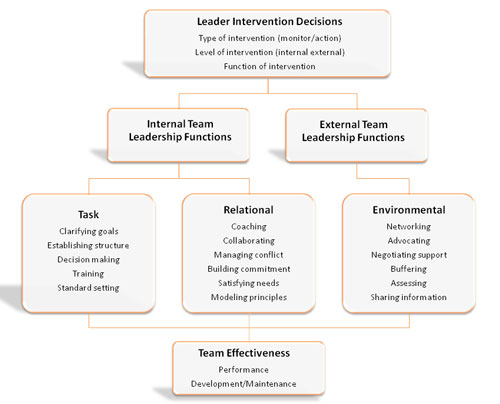Team Leadership Model
 A lack of leadership is often seen as a roadblock to a team's performance. As Stewart and Manz (1995, p.748) write,
A lack of leadership is often seen as a roadblock to a team's performance. As Stewart and Manz (1995, p.748) write,
“More specifically, work team management or supervision is often identified as a primary reason why self-management teams fail to properly develop and yield improvements in productivity, quality, and quality of life for American workers.”
Rather than focusing on ineffective teams, Larson and LaFasto (1989) looked in the opposite direction by interviewing excellent teams to gain insights as to what enables them to function to a high degree. They came away with the following conclusions:
- A clear elevating goal — they have a vision
- Results driven structure — visions have a business goal
- Competent team members — with right number and mix of diversity
- Unified commitment — they are a team, not a group
- A collaborative climate — aligned towards a common purpose
- High standards of excellence — they have group norms
- Principled leadership — the central driver of excellence
- External support — they have adequate resources
Team Leadership Model
While there are several Team Leadership models, Hill's Team model is perhaps one of the best known ones as it provides the leader or a designated team member with a mental road map to help diagnose team problems, and then take appropriate action to correct team problems (Northouse, 2007). This Team Leadership model is built on a number of research projects:
Hill's Team Leadership Model

The Four Layers or Steps in the Team Leadership Model
1. Top layer: Effective team performance begins with leader’s mental model of the situation and then determining if the situation requires Action or Monitoring?
2. Second Layer: Is it at an Internal or External leadership level?
3. Third layer: Is it Task, Relational, or an Environmental intervention? Select a function depending on the type of intervention. See the next section for explanation of Function Interventions.
4. Bottom layer: Correctly performing the above three steps create high Performance through Development and Maintenance functions.
Team Leadership Function Interventions
Internal Task Functions:
-
Focus on goals by clarifying and/or getting agreement
-
Restructure plans, processes, roles, etc. in order to gain desired results (process improvement)
-
Guide the decision-making process so that better information is obtained, coordination is better, focusing on issues, etc.
-
Train members through both formal and informal means
-
Assess performance an confront when necessary
Internal Relationship Functions
-
Coach team members
-
Use more collaborative methods to involve all team members (this survey includes questions to determine if the environment is collaborative)
-
Manage conflict
-
Build commitment and esprit de corps through the use of ethos leadership
-
Satisfy team members' needs
-
Model what you expect from your team members
External Environmental Functions
-
Network to increase influence and gather information
-
Advocate by representing your team so that it shows them at their best
-
Get support for your team by gathering resources and recognition for your team
-
Buffer the team from environmental distractions
-
Assess the environment through surveys and other performance indicators to determine its impact on the organization
-
Share information with the team
Next Steps
Next chapter: Horizontal Leadership: Flattening the Organization
Activity: Team leadership Survey
Related Pages:
-
Growing a Team: Tips for producing a high performance team.
-
Matrix Teams: geared towards organizational members from different functions or departments (matrix) collaborating to achieve a common goal.
References
Larson, C.E., LaFasto, F.M.J. (1989). Teamwork: What must go right, what can go wrong. Newberry Park, CA: Sage.
Northouse, G. (2007). Leadership Theory and Practice. Thousand Oaks, CA: Sage Publications, Inc.
Stewart, G.L., Manz, C.C. (1995). Leadership for self-managing work teams: A typology and integrative model. Human Relations, 48(7), 747-770.
